Beaks of the Incirrata are quite distinctive.
An example from each family and a representative of a benthis octopodid follows:
|
Lower
beak
| 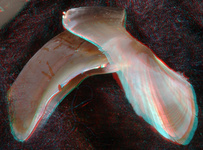
| 
| 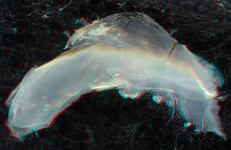
| 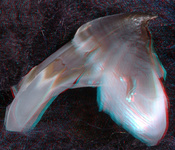
|
| | Octopus cyanea, ? mm ML, 5.5 mm
HL. BENTHIC
| Haliphron atlanticus, about 150 mm ML,
14 mm HL.
| Tremoctopus gracilis. 54 mm ML, 6.5 mm
HL.
| Ocythoe tuberculata, ? mm ML, 8 mm HL.
|
|
Lower
beak
| 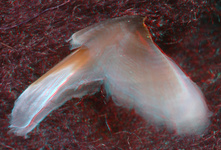
| 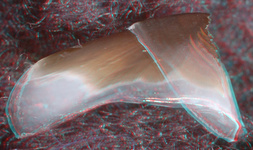
| 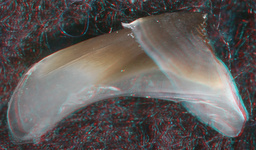
| 
|
| | Argonauta argo, 30 mm ML, 3 mm
HL.
| Japetella diaphana, ? mm ML, 2.2 mm HL.
| Amphitretus pelagicus, 60 mm ML, 2.6
mm HL.
| Vitreledonella richardi, 90 mm ML, 1.2 mm HL.
|
|
Upper
beak
| 
| 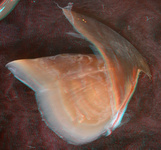
< | <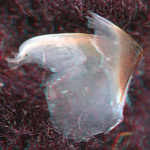
| <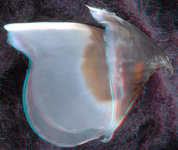
|
| | Octopus cyanea, sex ?, size ?, 2.7
mm URL (9.8 mm HL). BENTHIC
| Haliphron atlanticus, about 150 mm ML,
24 mm
HL .
| Tremoctopus gracilis. 35 mm ML, 2.4 mm
HL. | Ocythoe tuberculata, ? mm ML, 13 mm HL.
|
|
Upper
beak
| 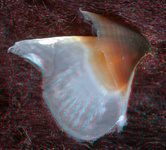
| 
| 
| 
|
| | Argonauta argo, 30 mm ML, 5 mm
HL (lower beak)
| Japetella diaphana, ? mm ML, 2.9 mm HL.
| Amphitretus pelagicus, 60 mm ML, 2.6
mm HL.
| Vitreledonella richardi, 90 mm ML, 1.8 mm HL.
|
Comparisons between beaks of cirrate families
Lower beak
- Pigmentation: Distinct pigmentation pattern on lateral walls and crest of Ocythoe (see side-view above) when not fully pigmented.
- Rostrum (also see side views at top of page):
- Absent ("negative" rostrum = small embayment) in Tremoctopus.

Click on an image to view larger version & data in a new window
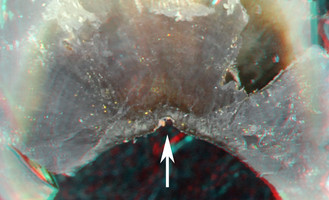
Figure. Top view of the rostral area of the lower beak of Tremoctopus gracilis. Arrow points to embayment.
- Indistinct, sometmes virtually absent, poorly differentiated from shoulder, in Japetella and Amphitretus.

Click on an image to view larger version & data in a new window
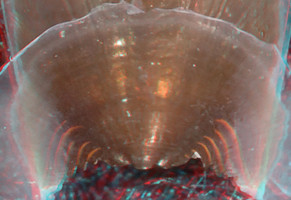

Figure. Top view of the rostral area of the lower beaks of Japetella diaphana (left) and Amphitretus pelagicus (right).
- Distinct but small and not protruding beyond shoulder in Vitreledonella.

Click on an image to view larger version & data in a new window
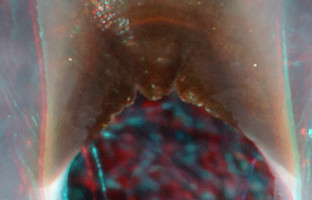
Figure. Top view of the rostral area of the lower beak of Vitreledonella richardi.
- Present, large and strongly protruding in Haliphron and Ocythoe; the form of the beak, however, differs between these two.

Click on an image to view larger version & data in a new window
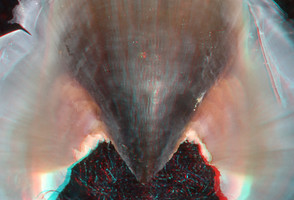
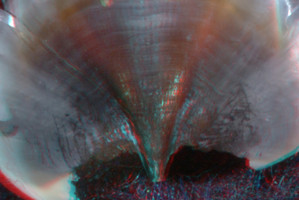
Figure. Top view of the rostral area of the lower beaks of Haliphron atlanticus and Ocythoe tuberculata (right).
- Distinct but small in Argonauta (note the peculiar "flying-bird" shape of the fused region of the hood-rostrum - see insert below photographed in transmitted light).

Click on an image to view larger version & data in a new window
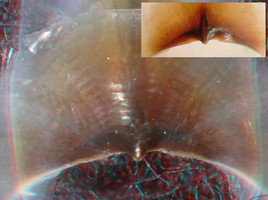
Figure. Top view of the rostral area of the lower beak of Argonauta argo. The fused area of the rostrum and jaw edge seem in the insert is also visible in the larger picture.
- Shoulder bars: Present in Japetella (and Bolitaena), Amphitretus and young Haliphron. Bars are less distinct in larger beaks and nearly undetectable in large Haliphron (barely recognizable at 60 mm ML).

Click on an image to view larger version & data in a new window

Figure. Top view of the rostral area of the lower beak of Amphitretus showing shoulder bars (arrow).
Upper beak
- Rostrum (also see side views at top of page and note similarity with lower beak rostra):
- Absent ("negative" rostrum = small embayment) in Tremoctopus
as in lower beak.

Click on an image to view larger version & data in a new window
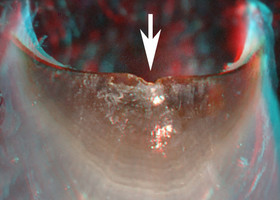
Figure. Top view of the rostral area of the upper beak of Tremoctopus gracilis. Arrow points to embayment.
- Indistinct, sometmes virtually absent, poorly differentiated from shoulder, and broadly rounded at tip in Japetella and Amphitretus.

Click on an image to view larger version & data in a new window
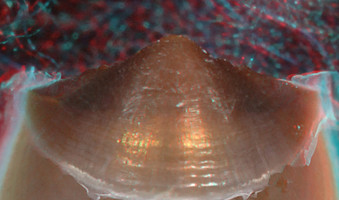
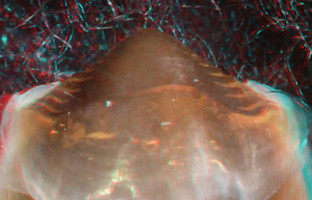
Figure. Top views of the rostral area of the upper beaks of Japetella diaphana (left) and Amphitretus pelagicus (right).
- Indistinct and not protruding beyond shoulder in Vitreledonella. Note the three bumps along the leading edge of the rostral area that recalls the similar, but more distinct, structure in the upper beak. Since only one beak has been examined, it rremains to be determined whether or not this similarity is real or accidental.

Click on an image to view larger version & data in a new window
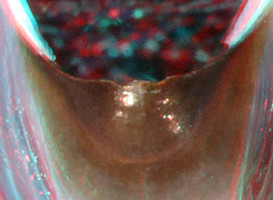
Figure. Top-frontal view of the rostral area of the upper beak of Vitreledonella richardi.
- Present, large and strongly protruding in Haliphron and Ocythoe.

Click on an image to view larger version & data in a new window
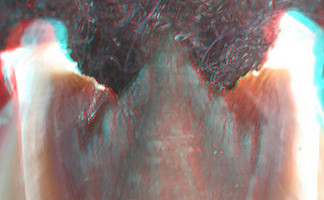

Figure. Top view of the rostral area of the upper beaks of Haliphron atlanticus and Ocythoe tuberculata (right). Note visibility of shoulder bars in Haliphron due to over exposure of this area during photographing.
- Indistinct but rostrum terminates in a point in Argonauta rather being broadly rounded.

Click on an image to view larger version & data in a new window
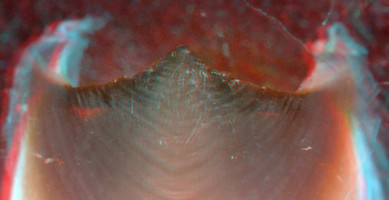
Figure. Top view of the rostral area of the upper beak of Argonauta argo.
- Shoulder bars: Present and distinct in Amphitretus but difficult to detect (or undetectable ??) in young Japetella (see these genera under "Upper beak "Rostra". Presumably present and apparent in young Haliphron since they are barely visibile in a relatively large, 60 mm ML Haliphron (see Upper beak "Rostra" for Haliphron.
- Crest groove: Present in only Vitreledonella.

Click on an image to view larger version & data in a new window


Click on an image to view larger version & data in a new window
Figure. Top-frontal view of the upper beak of Vitreledonella richardi showing the groove in the crest.
- Hood: Very high above crest distinctive of Haliphron (see side view at top of page).
Similar beaks from other families
- Cirrate octopod, many of which are pelagic, have rather different beaks. In addition their very deep, usually near-bottom, habitats rarely overlap with those of the pelagic incirrates.
- Vampyroteuthis (sole vampyromorph), whose bathypelagic habitat strongly overlaps that of some pelagic incirrates, has very distinctive beaks.
About This Page

University of Hawaii, Honolulu, HI, USA
Correspondence regarding this page should be directed to Richard E. Young at
Page copyright © 2011
 Page: Tree of Life
Beaks of the pelagic Incirrata
Authored by
Richard E. Young.
The TEXT of this page is licensed under the
Creative Commons Attribution-NonCommercial License - Version 3.0. Note that images and other media
featured on this page are each governed by their own license, and they may or may not be available
for reuse. Click on an image or a media link to access the media data window, which provides the
relevant licensing information. For the general terms and conditions of ToL material reuse and
redistribution, please see the Tree of Life Copyright
Policies.
Page: Tree of Life
Beaks of the pelagic Incirrata
Authored by
Richard E. Young.
The TEXT of this page is licensed under the
Creative Commons Attribution-NonCommercial License - Version 3.0. Note that images and other media
featured on this page are each governed by their own license, and they may or may not be available
for reuse. Click on an image or a media link to access the media data window, which provides the
relevant licensing information. For the general terms and conditions of ToL material reuse and
redistribution, please see the Tree of Life Copyright
Policies.



































 Go to quick links
Go to quick search
Go to navigation for this section of the ToL site
Go to detailed links for the ToL site
Go to quick links
Go to quick search
Go to navigation for this section of the ToL site
Go to detailed links for the ToL site